Tracking the Botanic Iron Tonic Bitters – Botanic Medicine Company
07 December 2013
![]() Well, Joe Gourd has done it again with an e-mail containing a trade card showing three cats playing for an unlisted Botanic Iron Tonic Bitters – Botanic Medicine Company with a Fort Worth, Texas indication. Joe says:
Well, Joe Gourd has done it again with an e-mail containing a trade card showing three cats playing for an unlisted Botanic Iron Tonic Bitters – Botanic Medicine Company with a Fort Worth, Texas indication. Joe says:
Ferd, Here is another mystery for you. It happens to be an unlisted and potentially Texas bitters. “Botanic Iron Tonic Bitters” was manufactured by the Botanic Medicine Co., H. W. Williams & Co., Sole Agents, Fort Worth, Tex. (note that it does not say that the Botanic Medicine Co. is a Texas company). You can see that it was also distributed in Texas by the druggist named on the front of the card.
Your mission (if you choose to accept it) is to track down the Botanic Medicine Co. and prove that it existed in Texas. 🙂
Have a great day…….. Joe
I have accepted the mission. Let’s look at some clues.
BOTANIC IRON TONIC BITTERS
B. I. T. B.
A GREAT REMEDY FOR
Loss of Appetite, General Debility, Nervous Prostration, etc., etc.
Botanic Iron Tonic Bitters
Online searches in the cities of Sherman, and then Fort Worth, and then Texas, and then the surrounding region, and then the United States pull up no obvious hits for Botanic Iron Tonic Bitters. Some interesting similar listings can be found for a Dr. Gray’s Tonic Bitters, Central Botanical Company, Cherry Creek, NY, Botanic Bitters, F. E. Mayhew & Co,., San Francisco, Cal., Botanic Aromatic Bitters, New York City, and a few other Botanic Bitters references without other information. Dead end here, at least for now.
Botanic Medicine Company
This is kind of a dead end too because I find page after page of botanic and herbal medicine links for new age wellness etc.
H. W. Williams & Co., Sole Agents, Fort Worth Texas
Now, finally we are on to something. I find a little bit of information here about Henry W. Williams, Sr. (1838 – 1925) who was a native of Georgia who moved to Sherman, Texas in 1873 where he established his drug store in 1874. His wife died in 1880, leaving him with a son, Henry Williams, Jr.
Both father and son relocated in 1884 to Fort Worth, where the elder Williams opened a wholesale drug business. Besides being a druggist and importer, he sold other items like cigars, druggists’ sundries and manufacturers proprietary articles. Directory listings show his address at 305-315 W. 15th Street near Throckmorton. He also served as vice president of Farmers and Merchants National Bank.
This company letterhead pictured below also notes a Charles S. Williams. Charles is listed in Forth Worth directories in the same time period with Henry Williams. I wonder if Charles is the link to their New York office on 99 Maiden Lane? You can also see this on the letterhead. Unfortunately, I can find no additional corresponding information for Botanic Iron Tonic Bitters or Botanic Medicine Company to support the trade card and confirm that this is a Texas bitters. I would say there is a very high probability.
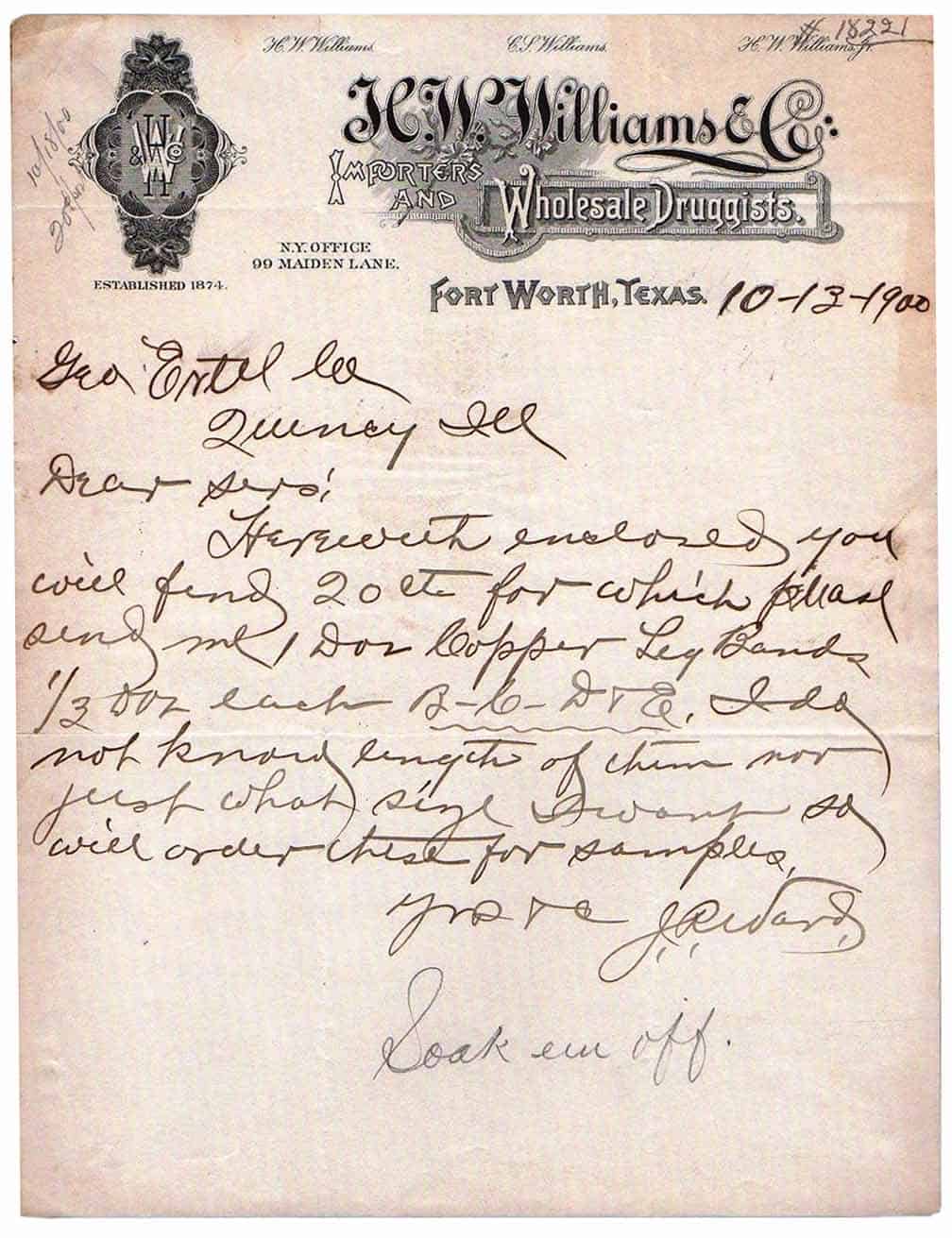
H. W. Williams & Co., Importers & Wholesale Druggists, Fort Worth, Texas letterhead, October 13, 1890 – ebay
The 99 Maiden Lane, New York Connection
The mysterious 99 Maiden Lane copy on the above letterhead could be a clue as it takes us back to the heart of historic merchant retail in New York City. Maybe the Botanic Iron Tonic Bitters came from here and was shipped to Fort Worth? It is really interesting to enlarge the below picture and try to find a sign relating to H. W. Williams, Botanic Iron Tonic Bitters or Botanic Medicine Company. Remember, I did find a listing for a Botanic Aromatic Bitters in New York City as noted further above.
Maiden Lane is an east-west street in the Financial District of the New York City borough of Manhattan. Its eastern terminus is at South Street, near the South Street Seaport. It continues west, terminating at Broadway, near the World Trade Center site.
The street received its name in New Amsterdam, as Maagde Paatje, a “footpath used by lovers along a rippling brook”, a “pebbly brook” that ran from Nassau Street to the East River where wives and daughters washed linen.
In September 1732, a company of professional actors arrived from London and took an upstairs room near the junction of Pearl Street which was fitted up with a platform stage, and marked the origin of professional theater in New York; by the time the company was disbanded in 1734, their building was known as the Play House.
In the Spring of 1790, Thomas Jefferson rented a house at 57 Maiden Lane when he moved to New York to serve as the Secretary of State under George Washington.
Maiden Lane was a street of shops by the end of the 18th century, even before the new fashion for multi-paned shop windows caught on in the city. In 1827 the skylit New York Arcade, banking on the fashionable success of London’s Burlington Arcade (1819), spanned the block between Maiden Lane and John Street east of Broadway with forty smart shops; “it had not the success that had been anticipated,” Charles Haynes Haswell recalled, “and survived but a few years”. Maiden Lane was soon one of the first city streets to be lit with gas lamps.
One of the handful of mid-19th century commercial structures still standing in the Financial District, is the building 90-94 Maiden Lane, built for Roosevelt & Son, with a cast-iron front (attributed to Charles Wright, 1870–71) by Daniel D. Badger. Until the early 20th century Maiden Lane was the center of the jewelry district, which relocated on West 47th Street. At Broadway, the bronze and glass clock embedded in the sidewalk by William Barthman Jewelers still keeps time; in 1946 the New York police department estimated that it was walked on by 51,000 people every weekday between 11 a.m. and 2 p.m. [parts from Wikipedia]
T. R. Legett, Druggist, Sherman, Texas (stamped in purple on front of trade card)
This is a tough one too. Henry W. Williams started out in Sherman, Texas so there is a connection. Thomas R. Legett was a druggist who owned a drug store in Sherman, Texas. He was born around 1864 in Arkansas and according to 1900 and 1910 Federal Census reports. His fathers birthplace was South Carolina, His mother was born in Alabama. He was married to Alice Herring on 11 September 1881. In his early life, he was a preacher as reported in the 1880 Federal Census. In another listing the settlement of Christoval began in the 1860s and increased in the 1870s and 1880s following the establishment of Fort Concho in nearby San Angelo. The town of Christoval began to develop by 1885. The South Concho Baptist congregation was organized in 1889 with four charter members. The Rev. T. R. Leggett served as first pastor at the Christoval Baptist Church.

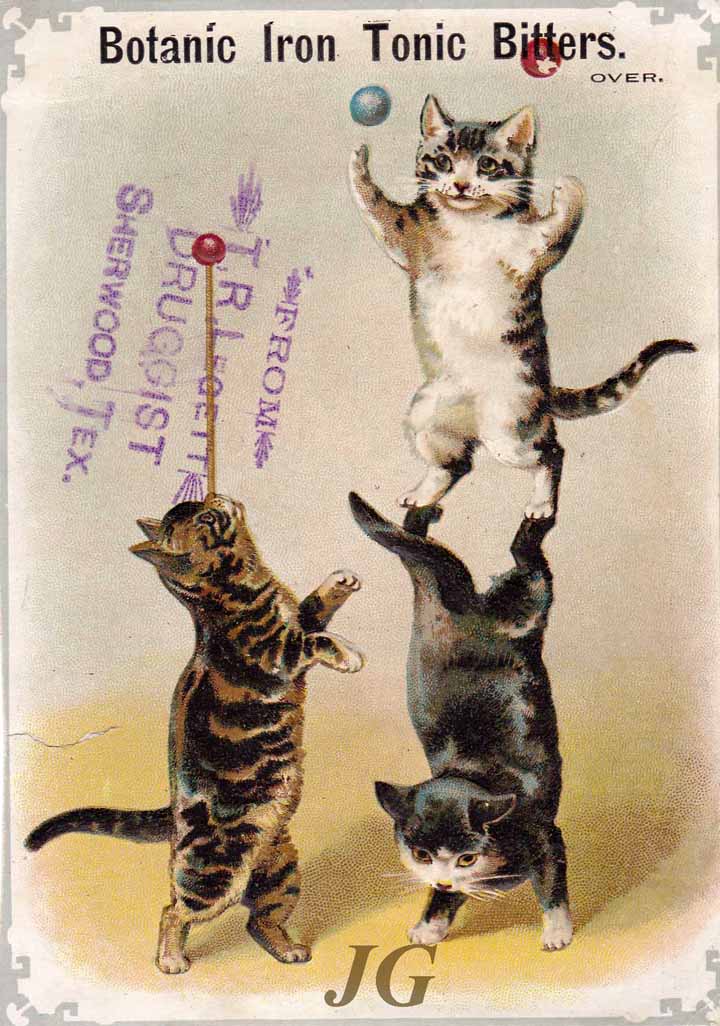
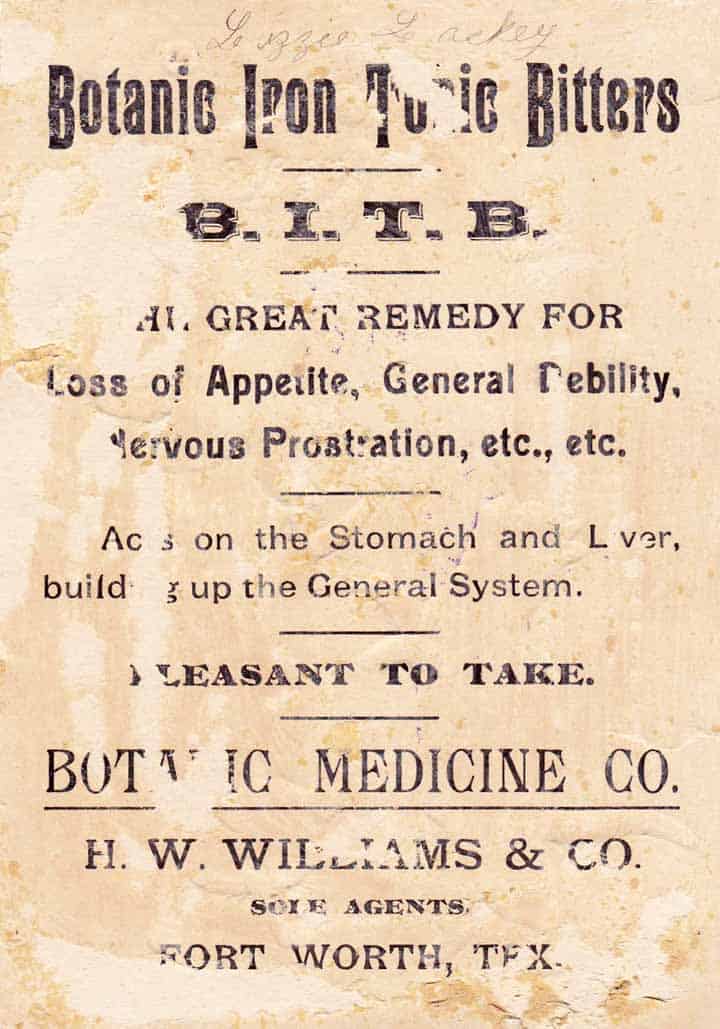
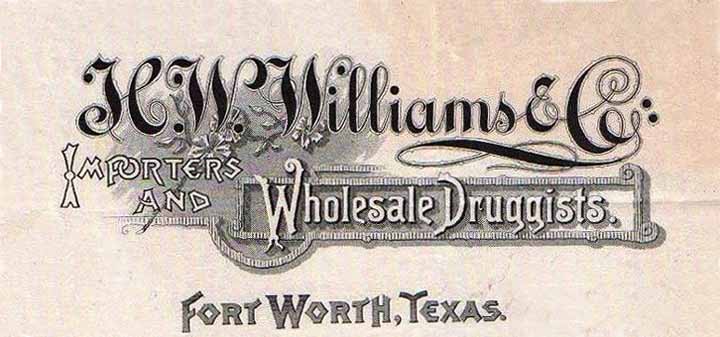
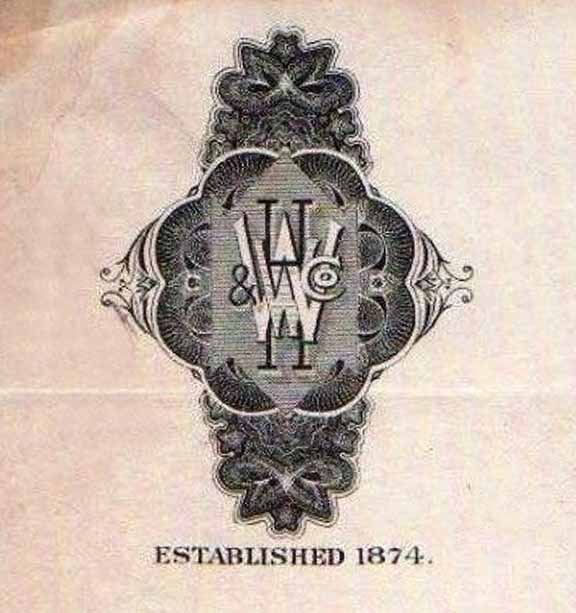
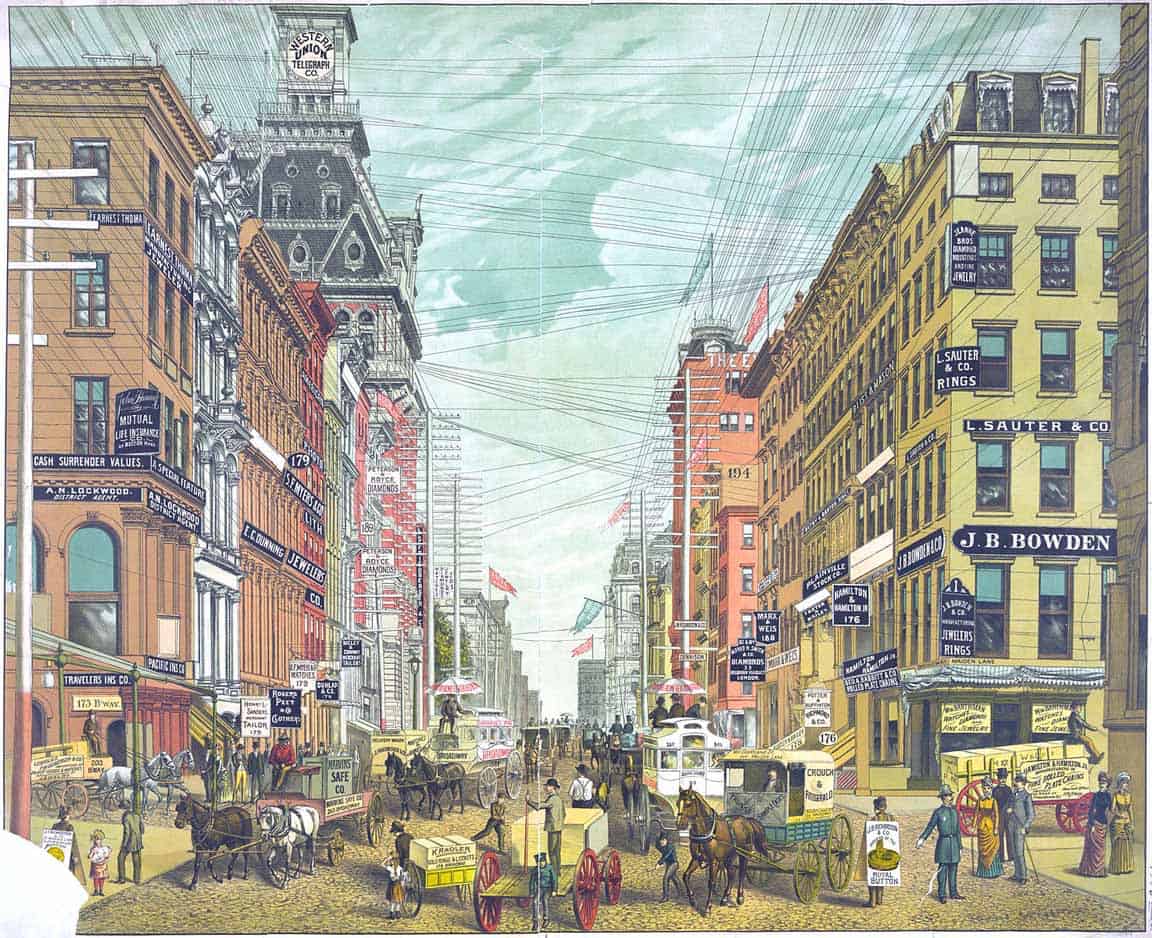
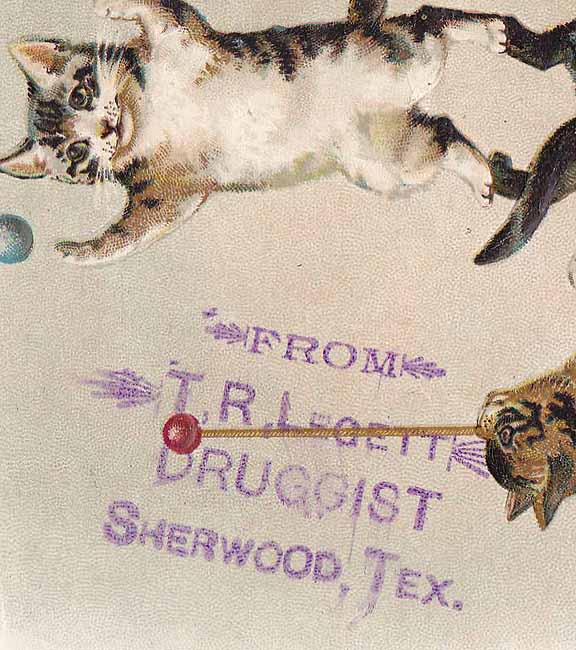
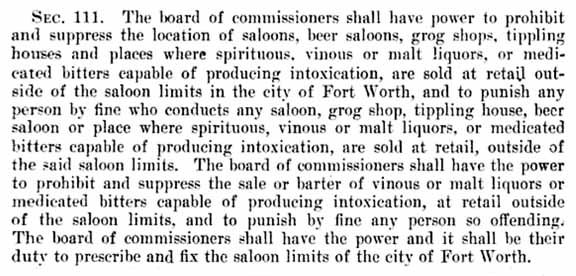







Ferdinand:
Very strange things do occur in life. My name is Elizabeth Harrison. Henry Washington Williams was my Great Great Grandfather. He had 2 sons, Charles Storey Williams and Henry Washington Williams. Charles was my Great Grandfather. He was born on June 13, 1867 at Sweet Home Plantation in Pine Mountain, Georgia. At the time, Henry owned the place after having purchased it from his father-in-law, James Storey (Story appears with and without the “e”) who built the house in 1840. James’ oldest son wasn’t interested in the place and Henry’s wife, Amanda loved it so legend has it that he purchased it for her. The place is still standing and according to various web sites, it is a lovely place to have a wedding. Still not sure why the family decided to head for Texas but a great number of people from the northwest corner of Georgia did leave and headed for Northern Texas. Henry Washington Junior was born in Arkansas (1872). Don’t know why, but perhaps it was on route to Texas. The family settled in Sherman. Amanda did give birth to a baby girl, May in 1880 but both she and the baby passed away shortly afterwards. According to the 1880 census, Amanda had Puerperal Fever (Childbed Fever). We believe that they are actually buried in Sherman although there are grave markers in Fort Worth. They did not move to Fort Worth until 1884 and the Oakwood Cemetery has no record of any actual burials for Amanda and the baby. Henry did remarry, but there were no children as far as anyone knows.
Henry did obtain a medical certificate in 1861 from The New Orleans School of Medicine. He did serve time in the CSA with a company called the Fannin Guards (B-60, Ga.) out of Troup County, Georgia. He is listed as a doctor but there are no other notations. Family rumour has it that he ended up being one of Lee’s personal doctors and was with him at the surrender. I have not been able to verify that but the Fannin Guards were indeed there. Fannin is also the name of one of the counties in Northern Texas.
I was told that he bought the plantation for his wife but do not know when or what he was up to until 1880 when he is listed on the census as being a druggist. After Henry married his 2nd wife, the family moved to Fort Worth. Where they lived initially, I am not sure. They did have a drug store in the downtown area which was later replaced in the by a giant warehouse style building. It was later demolished to make way for one of the freeway on (or off) ramps. Henry built a house for himself at about the same time and probably by the same architect (Saguinet). The house he built is on Crestline in Arlington Heights and is a national heritage spot with a plaque. My father and I were able to visit the house and have a tour of the insides in 2012 and it really is a nice house. The current owner is trying to restore it back to what it was and was very interested to see picture of it from the early days.
Henry was in business with both his sons but Charles died in 1917 from cirrhosis of the liver which meant that the business eventually went to Henry Jr. My great Grandfather was not known to be a nice man. He was a gambler, a drinker, a womanizer and we believe he abused his wife and my Grandmother. His matrimonial home was on Cherry Street and there is a parking lot there now. He only had one child, a girl (which he never liked because, he wanted a boy). She moved to Canada in 1912. Sometime after Charles died, his wife also moved to Canada. What we don’t know is how or what she inherited from her husband since the business was not his alone, but she had enough money to live until the 1959. Her daughter had only one son. Henry Jr. had two daughters. The eldest died at the age of 6 from burns received from a fireworks accident on Christmas Day in 1912. Her younger sister was not born until 1917. Henry built a house at 1200 Elizabeth Blvd. in the 1920’s and it appears to still be there. According to his death certificate, he was living on Crestline when he died. Henry Jr. died in 1944 and it seems that his wife inherited from him, but I don’t know if he still had the drug company. It was eventually bought out by the Southwest Texas Drug Co.? out of Waco, Texas. Maidee, their daughter was a great beauty and a debutante. She married three times and has 3 sons from 2 of the marriages. She was the final heir of the Williams money and unfortunately, she was a drinker and liked living the good life so there was nothing left when she passed away from the result of alcohol.
Now to your searches. Why there is a New York address on the letterhead is a mystery. We are not aware of any of the family ever living in New York. They did visit the northern states to escape the Texas summers, but Charles seems to have always lived in Fort Worth. The Williams’ did sell cigars and I have one of the cigar tokens. It has no date on it, so I have no idea if it is from the days when the family had the downtown store or if they sold cigars after the large wholesale building was built. I have also acquired a small bottle of Oil of Coriander. It is a small bottle with a cork stopper and a fairly plain brown label. There is still oil in the bottle and by chance, I bought the bottle from someone in Houston.
Now to the alcohol. By chance, my father told this story at Christmas dinner. When Charles was sill alive, a Methodist minister came around trying to collect money to buy a new horse. His had died. Charles said that he would give him a horse. Well, it seems that the drug company was still using horses for all the deliveries. The horse that Charles gave the minister had been used to make the deliveries of alcohol to bars and saloons etc. in town. The horse was so used to his route, that he kept taking the minister to the various saloons. I gather that my Great Grandfather thought this was a great joke. Now my father is under the impression that they were making pure grain alcohol at the drug company. It would not surprise me in the least, to learn that they were selling other types of liquor as well. I have also have the impression that the family maintained ties and had connections with people in Northern Texas and Charles married a girl from Norman, Oklahoma.
I do have some pictures of the family members and an architectural drawing of the large wholesale building. A photo of the completed building can be found on line.
Hope you manage to wade your way through this and that some of it is useful.
Elizabeth